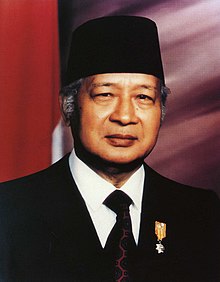Suharto
Suharto (June 8, 1921 - January 27, 2008[1]) was an Indonesian military general, political leader, and second President of Indonesia. He is the longest serving President of Indonesia (from 1967 to 1998).
Soeharto | |
|---|---|
 | |
| 2nd President of Indonesia | |
| In office March 12, 1967 – May 21, 1998 | |
| Vice President | Sri Sultan Hamengkubuwono IX (1973) Adam Malik (1978) Umar Wirahadikusumah (1983) Sudharmono (1988) Try Sutrisno (1993) Bacharuddin Jusuf Habibie (1998) |
| Preceded by | Sukarno |
| Succeeded by | Bacharuddin Jusuf Habibie |
| Personal details | |
| Born | June 8, 1921 Kemusuk, Yogyakarta, Indonesia |
| Died | January 27, 2008 (aged 86) Jakarta, Indonesia |
| Cause of death | Congestive heart failure caused by sepsis |
| Nationality | Indonesian |
| Political party | Golongan Karya |
| Height | 167 cm (5 ft 6 in) |
| Spouse(s) | Siti Hartinah |
| Children | Siti Hardiyanti Rukmana |
| Occupation | Military, Politician |
Biography
changeSuharto was born in the village of Kemusuk, near the city of Yogyakarta, Indonesia. He grew up in humble circumstances. During Indonesia's fight for independence, he joined the newly formed Indonesian Army.
Suharto rose to power after a failed coup by the Indonesian Communist Party that killed six generals in the Indonesian Army. The first president of Indonesia, Sukarno, was seen by both the people and political elites as being too close with the Communist Party and wanted him to step down.
Suharto was appointed as President by the Indonesian Parliament in 1967. Suharto ruled over Indonesia for over 30 years. His time as president was known as "Orde Baru" period. For most of his presidency, Indonesia experienced significant industrialisation, economic growth, and improved levels of education. He was given the title "Father of Development."
After mass demonstrations in 1998, Suharto resigned as president. His legacy remains hotly debated and contested both in Indonesia and abroad.
Suharto died in 2008 at Pertamina Hospital in Jakarta, Indonesia because of congestive heart failure.[2] He is buried at a family mausoleum near Solo, Central Java.
References
change- ↑ "Indonesia ex-leader Suharto dies". 27 January 2008.
- ↑ Watson, Richard C. Paddock and Paul. "Indonesian ex-president Suharto dies". baltimoresun.com. Archived from the original on 2019-05-11. Retrieved 2019-02-11.
Other websites
change| Military offices | ||
|---|---|---|
| Preceded by Pranoto Reksosamudro |
Indonesian Army Chief of Staff 1965 - 1967 |
Succeeded by Maraden Panggabean |
| Vacant Position abolished by Sukarno after 17 October 1952 incident Title last held by T.B. SimatupangAs Chief of Staff of the Battle Forces |
Commander-in-Chief of the Indonesian Armed Forces 1969 - 1973 | |
| Political offices | ||
| Preceded by Soekarno |
President of Indonesia 12 March 1967 - 21 May 1998 |
Succeeded by B. J. Habibie |
| Party political offices | ||
| New office | Chairman of Central Committee of Golkar 1983 - 1998 |
Succeeded by Harmoko |
| Diplomatic posts | ||
| Preceded by Dobrica Ćosić |
Secretary General of Non-Aligned Movement 1992 - 1995 |
Succeeded by Ernesto Samper Pizano |
| New office | Chairperson of APEC 1994 |
Succeeded by Tomiichi Murayama |